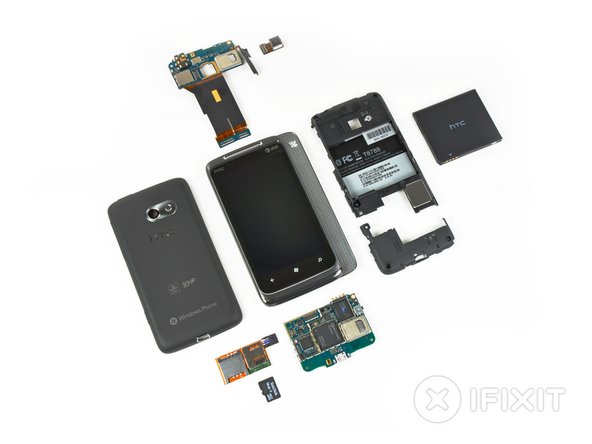
As it turns out, we’ve already seen a lot of this hardware in the Nexus One. In fact, five of the major chip packages on the Surround’s motherboard are identical to the Nexus One, and the sixth (Samsung NAND+SDRAM) appears to be just a revised chip found in Uncle Nexus. Hey if it ain’t broke, why fix it?
We gave the HTC Surround a mid-pack repairability score of 5 out of 10. It’s relatively easy to remove the rear case to replace the battery, but that’s where the fun stops. You’ll have to void your warranty to take anything else out, and it’s very difficult to access the front panel and LCD if you’d like to replace it.
Teardown highlights:
- A piece of gray EMI shielding tape (next to the SIM card holder) covers the Surround’s “internal storage” — which happens to be a well-hidden MicroSDHC card. And they would’ve gotten away with it too if it weren’t for us meddling kids!
- Should you decide that 16 GB isn’t enough, it definitely seems possible to swap out the card for a higher capacity MicroSDHC. But you’d have to void your warranty in order to do it, because two VOID stickers attached to the inner case screws ensure that no intrusion attempts go undocumented.
- The Surround has two Nexus One-esque motherboards that are attached with a large ribbon cable spanning the gap between them. This is not much of a surprise, as HTC is the manufacturer of both the Nexus One and the Surround.
- Big players on the front of the lower motherboard include:
- Qualcomm RTR6285 multi-band UMTS/EGPRS transceiver with integrated GPS
- Qualcomm Snapdragon QSD8250 1GHz RISC microprocessor with embedded DSP
- Samsung KA100O015E-BJTT 512 MB NAND Flash + 512 MB SDRAM
- Qualcomm PM7540 power management IC
- Skyworks SKY77336 power amplifier module
- Audience A1026 voice processor
- All six of the chips above are either identical to, or newer versions of, chips found in the Nexus One.
- The hefty metal slider mechanism should hold up to years of opening and closing the speaker grille.
- Like the Nexus One, the Surround utilizes dual microphones (working in conjunction with the Audience A1026 voice processor) to cancel background noise during phone conversations.
- The motherboard interconnect cable is sandwiched between the many layers of the upper motherboard, much like on the Nexus One. This technique eliminates the space requirements for thick connectors and sockets, making the final connection much thinner.
- Metal plates with strategically placed holes are soldered to the front of the Surround’s two speakers to direct the sound out of the fancy speaker grille, and not into the phone.


The Nexus One — err, the HTC Surround — is a very solid, capable phone that will undoubtedly please its users. Still, we’re a bit underwhelmed that HTC chose to put year-old hardware in it, especially since dual-core phones are coming right around the corner.




댓글 0개